Infiltration-Friendly Agroforestry Land Uses on Volcanic Slopes in the Rejoso Watershed, East Java, Indonesia
Abstract
1. Introduction
- Which existing land uses limit infiltration below the required rates at peak rainfall events?
- Which factors that are directly observable, such as tree cover, litter layer thickness, or surface roughness, can be used to define thresholds for “infiltration-friendly land use”?
- Do the answers to questions 1 and 2 need to be differentiated between the upper and middle watershed, with current vegetable production and agroforestry as dominant land uses, respectively?
2. Materials and Methods
2.1. Study Area
2.2. Land Cover Types Compared
2.3. Quantifying Terms of Water and Soil Balance
2.3.1. Overview
2.3.2. Rainfall and Throughfall
2.3.3. Water Infiltration and Soil Erosion Measurement
2.4. Determination of Soil Properties
2.5. Other Plot Characteristics
2.5.1. Canopy Cover
2.5.2. Understory and Litter
2.5.3. Land Surface Roughness
2.6. Data Analysis
3. Results
3.1. Rainfall and Throughfall
3.2. Soil Properties
3.3. Land Characteristics Related to Runoff and Soil Erosion
3.4. Runoff and Soil Erosion
3.5. Thresholds for Infiltration-Friendly Land Use
4. Discussion
5. Conclusions
Author Contributions
Funding
Acknowledgments
Conflicts of Interest
Appendix A
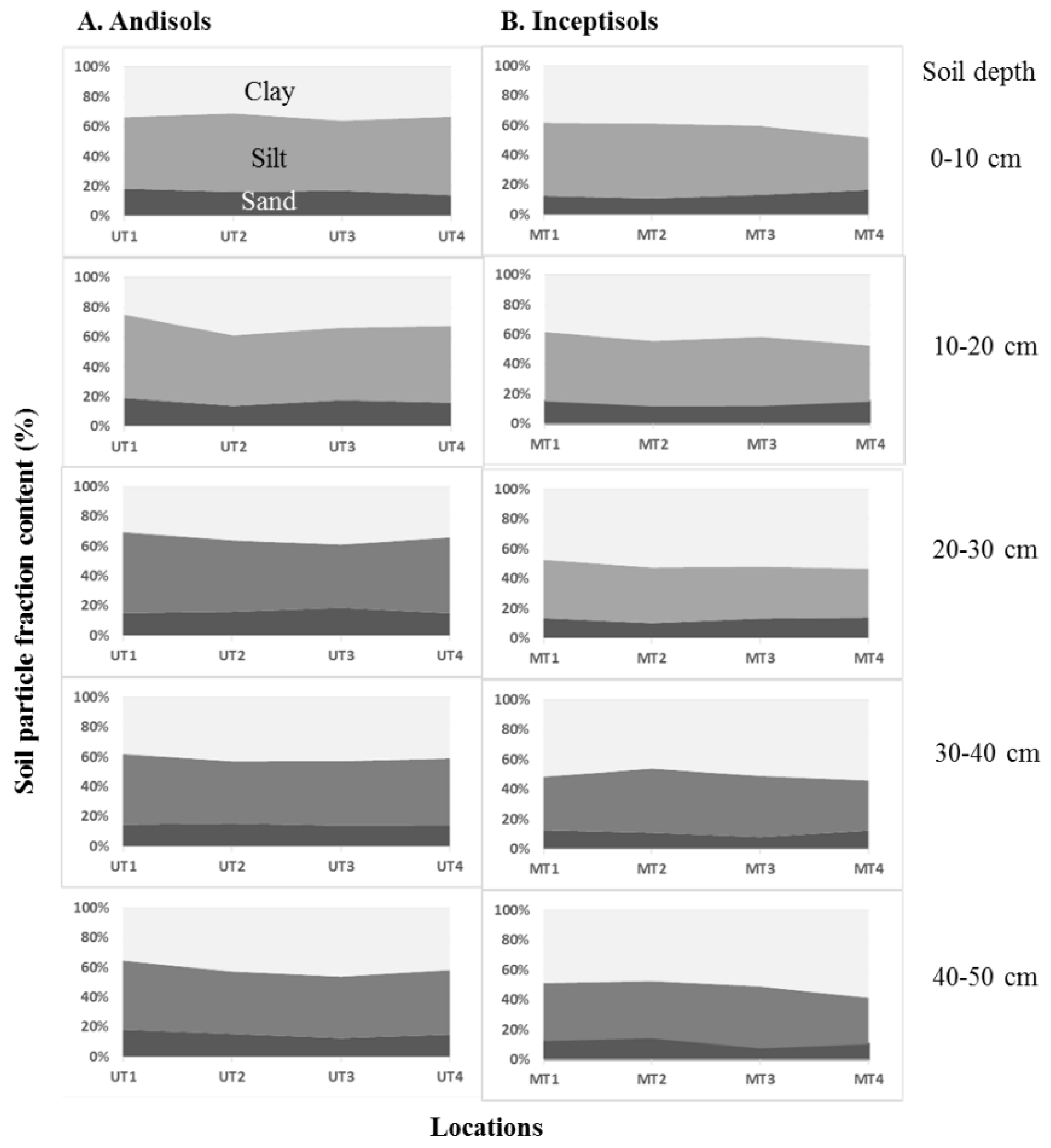
References
- UN-Water. 2018 UN World Water Development Report, Nature-Based Solutions for Water; UN-Water: Nairobi, Kenya, 2018. [Google Scholar]
- Ostovar, A.L. Investing upstream: Watershed protection in Piura, Peru. Environ. Sci. Policy 2019, 96, 9–17. [Google Scholar] [CrossRef]
- Ali, M.; Hadi, S.; Sulistyantara, B. Study on land cover change of Ciliwung downstream watershed with spatial dynamic approach. CITIES 2015 International Conference, Intelligent Planning towards Smart Cities, CITIES 2015, 3–4 November 2015, Surabaya, Indonesia. Procedia—Soc. Behav. Sci. 2016, 227, 52–59. [Google Scholar] [CrossRef]
- Jacobs, S.R.; Timbe, E.; Weeser, B.; Rufino, M.C.; Butterbach-Bahl, K.; Breuer, L. Assessment of hydrological pathways in East African montane catchments under different land use. Hydrol. Earth Syst. Sci. 2018, 22, 4981–5000. [Google Scholar] [CrossRef]
- Van Noordwijk, M.; Bayala, J.; Hairiah, K.; Lusiana, B.; Muthuri, C.; Khasanah, N.; Mulia, R. Agroforestry solutions for buffering climate variability and adapting to change. In Climate Change Impact and Adaptation in Agricultural Systems; Fuhrer, J., Gregory, P.J., Eds.; CAB-International: Wallingford, UK, 2014; pp. 216–232. [Google Scholar]
- Van Noordwijk, M.; Bargues-Tobella, A.; Muthuri, C.W.; Gebrekirstos, A.; Maimbo, M.; Leimona, B.; Bayala, J.; Ma, X.; Lasco, R.; Xu, J.; et al. Agroforestry as part of nature-based water management. In Sustainable Development through Trees on Farms: Agroforestry in Its Fifth Decade; van Noordwijk, M., Ed.; World Agroforestry (ICRAF): Bogor, Indonesia, 2019; pp. 261–287. [Google Scholar]
- Van Noordwijk, M.; Kim, Y.S.; Leimona, B.; Hairiah, K.; Fisher, L.A. Metrics of water security, adaptive capacity, and agroforestry in Indonesia. Curr. Opin. Environ. Sustain. 2016, 21, 1–8. [Google Scholar] [CrossRef]
- Filoso, S.; Bezerra, M.O.; Weiss, K.C.; Palmer, M.A. Impacts of forest restoration on water yield: A systematic review. PLoS ONE 2017, 12, e0183210. [Google Scholar] [CrossRef]
- Bentley, L.; Coomes, D.A. Partial river flow recovery with forest age is rare in the decades following establishment. Glob. Chang. Biol. 2020, 26, 1458–1473. [Google Scholar] [CrossRef]
- Zhang, J. Hydrological Response of a Fire-Climax Grassland and a Reforest Before and After Passage of Typhoon Haiyan (Leyte Island, the Philippines). Ph.D. Thesis, Free University, Amsterdam, The Netherlands, 2018. [Google Scholar]
- Bruijnzeel, L.A. Hydrological functions of tropical forests: Not seeing the soil for the trees? Agric. Ecosyst. Environ. 2004, 104, 185–228. [Google Scholar] [CrossRef]
- Peña-Arancibia, J.L.; Bruijnzeel, L.A.; Mulligan, M.; van Dijk, A.I. Forests as ‘sponges’ and ‘pumps’: Assessing the impact of deforestation on dry-season flows across the tropics. J. Hydrol. 2019, 574, 946–963. [Google Scholar] [CrossRef]
- Wiersum, K.F. Effects of various vegetation layers of an Acacia auriculiformis forest plantation on surface erosion in Java, Indonesia. In Soil Erosion and Conservation; El-Swaify, S.A., Moldenhauer, W.C., Lo, A., Eds.; John Wiley & Sons: Hoboken, NJ, USA, 1985; pp. 79–89. [Google Scholar]
- Hairiah, K.; Suprayogo, D.; Widianto, B.; Suhara, E.; Mardiastuning, A.; Widodo, R.H.; Prayogo, C.; Rahayu, S. Forests conversion into agricultural land: Litter thickness, earthworm populations and soil macro-porosity. Agrivita 2004, 26, 68–80. [Google Scholar]
- Suprayogo, D.; Widianto, K.; Hairiah, I.N. Watershed Management: Hydrological Consequences of Land Use Change during Development; Universitas Brawijaya Press: Malang, Indonesia, 2017. [Google Scholar]
- Creed, I.F.; van Noordwijk, M. Forest and Water on a Changing Planet: Vulnerability, Adaptation and Governance Opportunities; A Global Assessment Report. World Series Volume 38; IUFRO: Vienna, Austria, 2018. [Google Scholar]
- Jones, J.A.; Wei, X.; Archer, E.; Bishop, K.; Blanco, J.A.; Ellison, D.; Gush, M.; McNulty, S.G.; van Noordwijk, M.; Creed, I.F. Forest-Water Interactions under Global Change. In Forest-Water Interactions; Ecological Studies 240; Levia, D.F., Carlyle-Moses, D.E., Michalzik, B., Nanko, K., Tischer, A., Eds.; Springer Nature: Picassopl, Switzerland, 2020; pp. 589–624. [Google Scholar] [CrossRef]
- Liu, Y.; Cui, Z.; Huang, Z.; Miao, H.T.; Wu, G.L. The influence of litter crusts on soil properties and hydrological processes in a sandy ecosystem. Hydrol. Earth Syst. Sci. 2019, 23, 2481–2490. [Google Scholar] [CrossRef]
- Zhang, J.; van Meerveld, H.I.; Tripoli, R.; Bruijnzeel, L.A. Runoff response and sediment yield of a landslide-affected fire-climax grassland micro-catchment (Leyte, the Philippines) before and after passage of typhoon Haiyan. J. Hydrol. 2018, 565, 524–537. [Google Scholar] [CrossRef]
- Zhang, J.; Bruijnzeel, L.A.; Quiñones, C.M.; Tripoli, R.; Asio, V.B.; van Meerveld, H.J. Soil physical characteristics of a degraded tropical grassland and a ‘reforest’: Implications for runoff generation. Geoderma 2019, 333, 163–177. [Google Scholar] [CrossRef]
- Van Noordwijk, M.; Lawson, G.; Hairiah, K.; Wilson, J. Root distribution of trees and crops: Competition and/or complementarity. In Tree–Crop Interactions: Agroforestry in a Changing Climate; CABI: Wallingford, UK, 2015; pp. 221–257. [Google Scholar]
- Ellison, D.; Morris, C.E.; Locatelli, B.; Sheil, D.; Cohen, J.; Murdiyarso, D.; Gutierrez, V.; van Noordwijk, M.; Creed, I.F.; Pokorny, J. Trees, forests and water: Cool insights for a hot world. Glob. Environ. Chang. 2017, 43, 51–61. [Google Scholar] [CrossRef]
- Ellison, D.; Wang-Erlandsson, L.; van der Ent, R.J.; van Noordwijk, M. Upwind forests: Managing moisture recycling for nature-based resilience. Unasylva 2019, 251, 13–26. [Google Scholar]
- Van Noordwijk, M.; Tanika, L.; Lusiana, B. Flood risk reduction and flow buffering as ecosystem services—Part 1: Theory on flow persistence, flashiness and base flow. Hydrol. Earth Syst. Sci. 2017, 21, 2321–2340. [Google Scholar] [CrossRef]
- Shannon, P.D.; Swanston, C.W.; Janowiak, M.K.; Handler, S.D.; Schmitt, K.M.; Brandt, L.A.; Butler-Leopold, P.R.; Ontl, T. Adaptation strategies and approaches for forested watersheds. Rev. Artic. Clim. Serv. 2019, 13, 51–64. [Google Scholar] [CrossRef]
- Van Noordwijk, M.; Tanika, L.; Lusiana, B. Flood risk reduction and flow buffering as ecosystem services—Part 2: Land use and rainfall intensity effects in Southeast Asia. Hydrol. Earth Syst. Sci. 2017, 21, 2341–2360. [Google Scholar] [CrossRef]
- Coster, C. Wortelstudien in de tropen. V. Gebergtehoutsoorten [Root studies in the Tropics. V. Tree species of the mountain region]. Tectona 1935, 28, 861–878. [Google Scholar]
- Coster, C. De verdamping van verschillende vegetatievormen op Java [The transpiration of different types of vegetation in Java]. Tectona 1937, 30, 1–124. [Google Scholar]
- Gonggrijp, L. De verdamping van gebergtebosch in West Java op 1750–200 m zeehoogte [The transpiration of mountain forest in West Java at an elevation of 1750–2000 m above sea level]. Tectona 1941, 34, 437–447. [Google Scholar]
- Galudra, G.; Sirait, M. A discourse on Dutch colonial forest policy and science in Indonesia at the beginning of the 20th century. Int. For. Rev. 2009, 11, 524–533. [Google Scholar] [CrossRef]
- Government of Indonesia. Law (Undang-Undang) Number 26 Year 2007 about Spatial Planning; Government of Indonesia: Pemerintah, Indonesia, 2007.
- Van Noordwijk, M.; Creed, I.F.; Jones, J.A.; Wei, X.; Gush, M.; Blanco, J.A.; Sullivan, C.A.; Bishop, K.; Murdiyarso, D.; Xu, J.; et al. Climate-forest-water-people relations: Seven system delineations. In Forest and Water on a Changing Planet: Vulnerability, Adaptation and Governance Opportunities: A Global Assessment Report (No. 38); International Union of Forest Research Organizations (IUFRO): Vienna, Austria, 2018; pp. 27–58. [Google Scholar]
- Van Noordwijk, M.; Ekadinata, A.; Leimona, B.; Catacutan, D.; Martini, E.; Tata, H.L.; Öborn, I.; Hairiah, K.; Wangpakapattanawong, P.; Mulia, R.; et al. Agroforestry options for degraded landscapes in Southeast Asia. In Agroforestry for Degraded Landscapes: Recent Advances and Emerging Challenges; Dagar, J.C., Gupta, S.R., Teketay, D., Eds.; Springer: Singapore, 2020. [Google Scholar]
- Sajikumar, N.; Remya, R.S. Impact of land cover and land use change on runoff characteristics. J. Environ. Manag. 2015, 161, 460–468. [Google Scholar] [CrossRef] [PubMed]
- Anache, J.A.; Wendland, E.C.; Oliveira, P.T.; Flanagan, D.C.; Nearing, M.A. Runoff and soil erosion plot-scale studies under natural rainfall: A meta-analysis of the Brazilian experience. Catena 2017, 152, 29–39. [Google Scholar] [CrossRef]
- USGS. Landsat 8 OLI (2019-10-18 (6, 53). U.S. Geological Survey. 2019. Available online: https://earthexplorer.usgs.gov/ (accessed on 9 June 2020).
- Wischmeier, W.H. The USLE: Some reflections. J. Soil Water Conserv. 1984, 39, 105–107. [Google Scholar]
- Hairsine, P.B.; Rosem, C.W. Modeling water erosion due to overland flow using physical principles: 1. Sheet flow. Water Resour. Res. 1992, 28, 237–243. [Google Scholar] [CrossRef]
- Van Noordwijk, M.; van Roode, M.; McCallie, E.L.; Cadisch, G. Erosion and sedimentation as multiscale, fractal processes: Implications for models, experiments and the real world. In Soil Erosion at Multiple Scales, Principles and Methods for Assessing Causes and Impacts; Penning de Vries, F., Agus, F., Kerr, J., Eds.; CAB International: Wallingford, UK, 1998; pp. 223–253. [Google Scholar]
- Knox County Tennessee. Stormwater Management Manual, Section on the Rational Method, Volume 2 Technical Guidance. Available online: https://dec.alaska.gov/water/wastewater/stormwater/swppp-dev-runoff-coefficient-values-rm (accessed on 26 April 2020).
- Widianto, D.S.; Noveras, H.; Widodo, R.H.; Purnomosidhi, P.; van Noordwijk, M. Alih guna lahan hutan menjadi lahan pertanian: Apakah fungsi hidrologis hutan dapat digantikan sistem kopi monokultur? Agrivita 2004, 26, 47–52. [Google Scholar]
- Gee, G.W.; Bauder, J.W. Particle Size Analysis. In Methods of Soil Analysis Part 1, Physical and Mineralogical Methods, 2nd ed.; Klute, A., Ed.; American Society of Agronomy: Madison, WI, USA, 1986; Volume 9, pp. 383–411. [Google Scholar]
- Blake, G.R.; Hartge, K.H. Bulk density. In Methods of Soil Analysis. Part I: Physical and Mineralogical Methods; Klute, A.K., Ed.; American Society of Agronomy—Soil Science Society of America: Madison, WI, USA, 1986; pp. 363–375. [Google Scholar]
- Nimmo, J.R. Porosity and pore size distribution. In Encyclopedia of Soils in the Environment; Hillel, D., Ed.; Elsevier: London, UK, 2004; pp. 295–303. [Google Scholar]
- Walkley, A.; Black, I.A. An examination of the Degtjareff method for determining soil organic matter, and a proposed modification of the chromic acid titration method. Soil Sci. 1934, 37, 29–38. [Google Scholar] [CrossRef]
- Bouwer, H. Intake rate: Cylinder infiltrometer. In Methods of Soil Analysis; Klute, A., Ed.; ASA Monograph 9; ASA: Madison, WI, USA, 1986; pp. 825–843. [Google Scholar]
- Jennings, S.B.; Brown, N.D.; Sheil, D. Assessing forest canopies and understorey illumination: Canopy closure, canopy cover and other measures. Forestry 1999, 72, 59–73. [Google Scholar] [CrossRef]
- Hairiah, K.; Ekadinata, A.; Sari, R.R.; Rahayu, S. Measurement of Carbon Stock: From land level to landscape. In Practical Instructions, 2nd ed.; Bogor, World Agroforestry Centre, ICRAF SEA Regional Office, University of Brawijaya (UB): Malang, Indonesia, 2011; p. 110. Available online: http://apps.worldagroforestry.org/sea/Publications/files/manual/MN0049-11.pdf (accessed on 10 April 2020).
- Hoechsteetter, S.; Walz, U.; Dang, L.H.; Thinh, N.X. Effect of Topography and Surface Roughness in Analyses of Landscape Structure—A Proposal Modify the Existing Set of Landscape Metrics. Landsc. Online 2008, 3, 1–14. Available online: https://gfzpublic.gfz-potsdam.de/pubman/item/item_32854 (accessed on 10 April 2020). [CrossRef]
- Landon, J.R. Booker Tropical Soil Manual: A Handbook for Soil Survey and Agricultural Land Evaluation in the Tropics and Subtropics; Routledge: Abingdon, UK, 2014. [Google Scholar]
- Gifford, G.F.; Hawkins, R.H. Hydrologic impact of grazing on infiltration: A critical review. Water Resour. Res. 1978, 14, 305–313. [Google Scholar] [CrossRef]
- Widianto, D.S.; Purnomosidhi, P.; Widodo, R.H.; Rusiana, F.; ZAini, Z.; Khasanah, N.; Kusuma, Z. Degradasi sifat fisik tanah sebagai akibat alih guna lahan hutan menjadi sistem kopi monokultur: Kajian perubahan makroporositas tanah. Agrivita 2004, 26, 60–67. [Google Scholar]
- Neris, J.; Jiménez, C.; Fuentes, J.; Morillas, G.; Tejedor, M. Vegetation and land-use effects on soil properties and water infiltration of Andisols in Tenerife (Canary Islands, Spain). Catena 2012, 98, 55–62. [Google Scholar] [CrossRef]
- Ma, Q.; Wang, J.; Zhu, S. Effects of precipitation, soil water content and soil crust on artificial Haloxylon Ammodendron forest. Acta Ecol. Sin. 2007, 27, 5057–5067. [Google Scholar] [CrossRef]
- Sun, D.; Yang, H.; Guan, D.; Yang, M.; Wu, J.; Yuan, F.; Jin, C.; Wang, A.; Zhang, Y. The effects of land use change on soil infiltration capacity in China: A meta-analysis. Sci. Total Environ. 2018, 626, 1394–1401. [Google Scholar] [CrossRef] [PubMed]
- Zimmermann, B.; Elsenbeer, H.; De Moraes, J.M. The influence of land-use changes on soil hydraulic properties: Implications for runoff generation. For. Ecol. Manag. 2006, 222, 29–38. [Google Scholar] [CrossRef]
- Dunkerley, D. A Review of the Effects of Throughfall and Stemflow on Soil Properties and Soil Erosion. In Precipitation Partitioning by Vegetation; Springer: Cham, Germany, 2020; pp. 183–214. [Google Scholar]
- Colloff, M.J.; Pullen, K.R.; Cunningham, S.A. Restoration of an ecosystem function to revegetation communities: The role of invertebrate macropores in enhancing soil water infiltration. Restor. Ecol. 2010, 18, 65–72. [Google Scholar] [CrossRef]
- Reid, K.D.; Wilcox, B.P.; Breshears, D.D.; MacDonald, L. Runoff and erosion in a pinon–juniper woodland: Influence of vegetation patches. Soil Sci. Soc. Am. J. 1999, 63, 313–325. [Google Scholar] [CrossRef]
- Bhark, E.W.; Small, E.E. Association between plant canopies and the spatial patterns of infiltration in shrubland and grassland of the Chihuahuan Desert, New Mexico. Ecosystems 2003, 6, 185–196. [Google Scholar] [CrossRef]
- Van Noordwijk, M.; Heinen, M.; Hairiah, K. Old tree root channels in acid soils in the humid tropics: Important for crop root penetration, water infiltration and nitrogen management. In Plant-Soil Interactions at Low pH; Springer: Dordrecht, The Netherlands, 1991; pp. 423–430. [Google Scholar]
- Wu, G.L.; Liu, Y.; Yang, Z.; Cui, Z.; Deng, L.; Chang, X.F.; Shi, Z.H. Root channels to indicate the increase in soil matrix water infiltration capacity of arid reclaimed mine soils. J. Hydrol. 2017, 546, 133–139. [Google Scholar] [CrossRef]
- Zwartendijk, B.W.; Van Meerveld, H.J.; Ghimire, C.P.; Bruijnzeel, L.A.; Ravelona, M.; Jones, J.P.G. Rebuilding soil hydrological functioning after swidden agriculture in eastern Madagascar. Agric. Ecosyst. Environ. 2017, 239, 101–111. [Google Scholar] [CrossRef]
- Van Meerveld, H.J.; Zhang, J.; Tripoli, R.; Bruijnzeel, L.A. Effects of reforestation of a degraded Imperata grassland on dominant flow pathways and streamflow responses in Leyte, the Philippines. Water Resour. Res. 2019, 55, 4128–4148. [Google Scholar] [CrossRef]
- Sanchez, P.A. Properties and Management of Soils in the Tropics; Cambridge University Press: Cambridge, UK, 2019. [Google Scholar]
- Mwendera, E.J.; Saleem, M.M. Infiltration rates, surface runoff, and soil loss as influenced by grazing pressure in the Ethiopian highlands. Soil Use Manag. 1997, 13, 29–35. [Google Scholar] [CrossRef]
- Martens, D.A.; Frankenberger, W.T. Modification of Infiltration Rates in an Organic-Amended Irrigated. Agron. J. 1992, 84, 707–717. [Google Scholar] [CrossRef]
- Osuji, G.E.; Okon, M.A.; Chukwuma, M.C.; Nwarie, I.I. Infiltration characteristics of soils under selected land use practices in Owerri, Southeastern Nigeria. World J. Agric. Sci. 2010, 6, 322–326. [Google Scholar]
- Bons, C.A. Accelerated erosion due to clearcutting of plantation forest and subsequent Taungya cultivation in upland West Java, Indonesia. Int. Assoc. Hydrol. Sci. Publ. 1990, 192, 279–288. [Google Scholar]
- Rijsdijk, A.; Bruijnzeel, L.S.; Sutoto, C.K. Runoff and sediment yield from rural roads, trails and settlements in the upper Konto catchment, East Java, Indonesia. Geomorphology 2007, 87, 28–37. [Google Scholar] [CrossRef]
- Purwanto, E.; Bruijnzeel, L.A. Soil conservation on rainfed bench terraces in upland West Java, Indonesia: Towards a new paradigm. In Advances in Geoecology; Catena: Reiskirchen, Germany, 1998; pp. 1267–1274. [Google Scholar]
- Van Dijk, A.I.J.M.; Bruijnzeel, L.A.; Wiegman, S.E. Measurements of rain splash on bench terraces in a humid tropical steepland environment. Hydrol. Process. 2003, 17, 513–535. [Google Scholar] [CrossRef]
- Marin, C.T.; Bouten, W.; Sevink, J. Gross rainfall and its partitioning into throughfall, stemflow and evaporation of intercepted water in four forest ecosystems in western Amazonia. J. Hydrol. 2000, 237, 40–57. [Google Scholar] [CrossRef]
- Holwerda, F.; Scatena, F.N.; Bruijnzeel, L.A. Throughfall in a Puerto Rican lower montane rain forest: A comparison of sampling strategies. J. Hydrol. 2006, 327, 592–602. [Google Scholar] [CrossRef]
- Klos, P.Z.; Chain-Guadarrama, A.; Link, T.E.; Finegan, B.; Vierling, L.A.; Chazdon, R. Throughfall heterogeneity in tropical forested landscapes as a focal mechanism for deep percolation. J. Hydrol. 2014, 519, 2180–2188. [Google Scholar] [CrossRef]
- Muzylo, A.; Llorens, P.; Valente, F.; Keizer, J.J.; Domingo, F.; Gash, J.H.C. A review of rainfall interception modelling. J. Hydrol. 2009, 370, 191–206. [Google Scholar] [CrossRef]
- Van Stan, J.T.; Lewis, E.S.; Hildebrandt, A.; Rebmann, C.; Friesen, J. Impact of interacting bark structure and rainfall conditions on stemflow variability in a temperate beech-oak forest, central Germany. Hydrol. Sci. J. 2016, 61, 2071–2083. [Google Scholar] [CrossRef]
- Friesen, P.; Park, A.; Sarmiento-Serrud, A.A. Comparing rainfall interception in plantation trials of six tropical hardwood trees and wild sugar cane Saccharum spontaneum L. Ecohydrology 2013, 6, 765–774. [Google Scholar]
- Taniguchi, M.; Tsujimura, M.; Tanaka, T. Significance of stemflow in groundwater recharge. 1: Evaluation of the stemflow contribution to recharge using a mass balance approach. Hydrol. Process. 1996, 10, 71–80. [Google Scholar] [CrossRef]
- Cattan, P.; Bussière, F.; Nouvellon, A. Evidence of large rainfall partitioning patterns by banana and impact on surface runoff generation. Hydrol. Process. 2007, 21, 2196–2205. [Google Scholar] [CrossRef]
- Siles, P.; Vaast, P.; Dreyer, E.; Harmand, J.M. Rainfall partitioning into throughfall, stemflow and interception loss in a coffee (Coffea arabica L.) monoculture compared to an agroforestry system with Inga densiflora. J. Hydrol. 2010, 395, 39–48. [Google Scholar] [CrossRef]
- Niether, W.; Armengot, L.; Andres, C.; Schneider, M.; Gerold, G. Shade trees and tree pruning alter throughfall and microclimate in cocoa (Theobroma cacao L.) production systems. Ann. For. Sci. 2018, 75, 38. [Google Scholar] [CrossRef]
- Bruijnzeel, L.A.; Wiersum, K.F. Rainfall interception by a young Acacia auriculiformis (A. Cunn) plantation forest in west Java, Indonesia: Application of Gash’s analytical model. Hydrol. Process. 1987, 1, 309–319. [Google Scholar] [CrossRef]
- de Almeida, W.S.; Panachuki, E.; de Oliveira, P.T.S.; da Silva Menezes, R.; Sobrinho, T.A.; de Carvalho, D.F. Effect of soil tillage and vegetal cover on soil water infiltration. Soil Tillage Res. 2018, 175, 130–138. [Google Scholar] [CrossRef]
- Toohey, R.C.; Boll, J.; Brooks, E.S.; Jones, J.R. Effects of land use on soil properties and hydrological processes at the point, plot, and catchment scale in volcanic soils near Turrialba, Costa Rica. Geoderma 2018, 315, 138–148. [Google Scholar] [CrossRef]
- Nespoulous, J.; Merino-Martin, L.; Monnier, Y.; Bouchet, D.C.; Ramel, M.; Dombey, R.; Viennois, G.; Mao, Z.; Zhang, J.L.; Cao, K.F.; et al. Tropical forest structure and understorey determine subsurface flow through biopores formed by plant roots. Catena 2019, 181, 104061. [Google Scholar] [CrossRef]
- Johnson, M.S.; Lehmann., J. Double-Funneling of trees: Stemflow and root-induced preferential flow. Ecoscience 2006, 13, 324–333. [Google Scholar] [CrossRef]
- Gonzalez-Ollauri, A.; Stokes, A.; Mickovski, S.B. A novel framework to study the effect of tree architectural traits on stemflow yield and its consequences for soil-water dynamics. J. Hydrol. 2020, 582, 124448. [Google Scholar] [CrossRef]
- Liang, W.L. Effects of Stemflow on Soil Water Dynamics in Forest Stands. In Forest-Water Interactions; Springer: Cham, Germany, 2020; pp. 349–370. [Google Scholar]
- Badu, M.; Nuberg, I.; Ghimire, C.P.; Bajracharya, R.M.; Meyer, W.S. Negative Trade-Offs between Community Forest Use and Hydrological Benefits in the Forested Catchments of Nepal’s Mid-hills. Mt. Res. Dev. 2020, 39, 822–832. [Google Scholar] [CrossRef]
- Li, X.; Niu, J.; Xie, B. The Effect of Leaf Litter Cover on Surface Runoff and Soil Erosion in Northern China. PLoS ONE 2014, 9, e107789. [Google Scholar] [CrossRef]
- Hairiah, K.; Sulistyani, H.; Suprayogo, D.; Purnomosidhi, P.; Widodo, R.H.; Van Noordwijk, M. Litter layer residence time in forest and coffee agroforestry systems in Sumberjaya, West Lampung. For. Ecol. Manag. 2006, 224, 45–57. [Google Scholar] [CrossRef]
- Derpsch, R.; Franzluebbers, A.J.; Duiker, S.W.; Reicosky, D.C.; Koeller, K.; Friedrich, T.; Sturny, W.G.; Sá, J.C.M.; Weiss, K. Why do we need to standardize no-tillage research? Soil Tillage Res. 2014, 137, 16–22. [Google Scholar] [CrossRef]
- Stomph, T.J.; De Ridder, N.; Steenhuis, T.S.; Van de Giesen, N.C. Scale effects of Hortonian overland flow and rainfall-runoff dynamics: Laboratory validation of a process-based model. Earth Surf. Process. Landf. 2002, 27, 847–855. [Google Scholar] [CrossRef]
- Gomi, T.; Sidle, R.C.; Miyata, S.; Kosugi, K.I.; Onda, Y. Dynamic runoff connectivity of overland flow on steep forested hillslopes: Scale effects and runoff transfer. Water Resour. Res. 2008, 44, 1–16. [Google Scholar] [CrossRef]
- Moreno-de las Heras, M.; Nicolau, J.M.; Merino-Martín, L.; Wilcox, B.P. Plot-Scale effects on runoff and erosion along a slope degradation gradient. Water Resour. Res. 2010, 46, 1–12. [Google Scholar] [CrossRef]
- Rodenburg, J.; Stein, A.; van Noordwijk, M.; Ketterings, Q.M. Spatial variability of soil pH and phosphorus in relation to soil run-off following slash-and-burn land clearing in Sumatra, Indonesia. Soil Tillage Res. 2003, 71, 1–14. [Google Scholar] [CrossRef]
- Pradiko, H.; Soewondo, P.; Suryadi, Y. The change of hydrological regime in upper Cikapundung Watershed, West Java Indonesia. Procedia Eng. 2015, 125, 229–235. [Google Scholar] [CrossRef][Green Version]
- Nurhayati, S.A.; Sabar, A.; Marselina, M. The effect of land use changes to discharge extremities in Cimahi Watershed–Upper Citarum Watershed, West Java. In E3S Web of Conferences; EDP Sciences: Ulis, France, 2020; Volume 148, p. 07002. [Google Scholar]
- Beven, K. Searching for the Holy Grail of scientific hydrology: Q t=(S, R,? t) a as closure. Hydrol. Earth Syst. Sci. Discuss. 2006, 10, 609–618. [Google Scholar] [CrossRef]
- Graham, C.B.; Van Verseveld, W.; Barnard, H.R.; McDonnell, J.J. Estimating the deep seepage component of the hillslope and catchment water balance within a measurement uncertainty framework. Hydrol. Process. 2010, 24, 3631–3647. [Google Scholar] [CrossRef]
- Government of Indonesia. Law (Undang-Undang) Number 41 Year 1999 about Forestry; Government of Indonesia: Pemerintah, Indonesia, 1999.
- Bruijnzeel, L.A. Evaluation of runoff sources in a forested basin in a wet monsoonal environment: A combined hydrological and hydrochemical approach. Hydrol. Humid Trop. Reg. IAHS Publ. 1983, 140. [Google Scholar]
- Verbist, B.; Poesen, J.; van Noordwijk, M.; Suprayogo, D.; Agus, F.; Deckers, J. Factors affecting soil loss at plot scale and sediment yield at catchment scale in a tropical volcanic agroforestry landscape. Catena 2010, 80, 34–46. [Google Scholar] [CrossRef]
- Tanika, L.; Khasanah, N.; Leimona, B. Simulasi Dampak Perubahan Tutupan Lahan Terhadap Neraca Air Di Das Dan Sub-Das Rejoso Menggunakan Model. Genriver; Report; World Agroforestry Centre (ICRAF) Southeast Asia Regional Program: Bogor, Indonesia, 2018. [Google Scholar]
- Ridwansyah, I.; Pawitan, H.; Sinukaban, N.; Hidayat, Y. Watershed Modeling with ArcSWAT and SUFI2 in Cisadane Catchment Area: Calibration and Validation of River Flow Prediction. Int. J. Sci. Eng. 2014, 6, 92–101. [Google Scholar] [CrossRef]
- Liu, Z.; Ma, D.; Hu, W.; Li, X. Land use dependent variation of soil water infiltration characteristics and their scale-specific controls. Soil Tillage Res. 2018, 178, 139–149. [Google Scholar] [CrossRef]
- Zhao, Y.; Wang, Y.; Wang, L.; Zhang, X.; Yu, Y.; Zhao, J.; Lin, H.; Chen, Y.; Zhou, W.; An, Z. Exploring the role of land restoration in the spatial patterns of deep soil water at watershed scales. Catena 2019, 172, 387–396. [Google Scholar] [CrossRef]
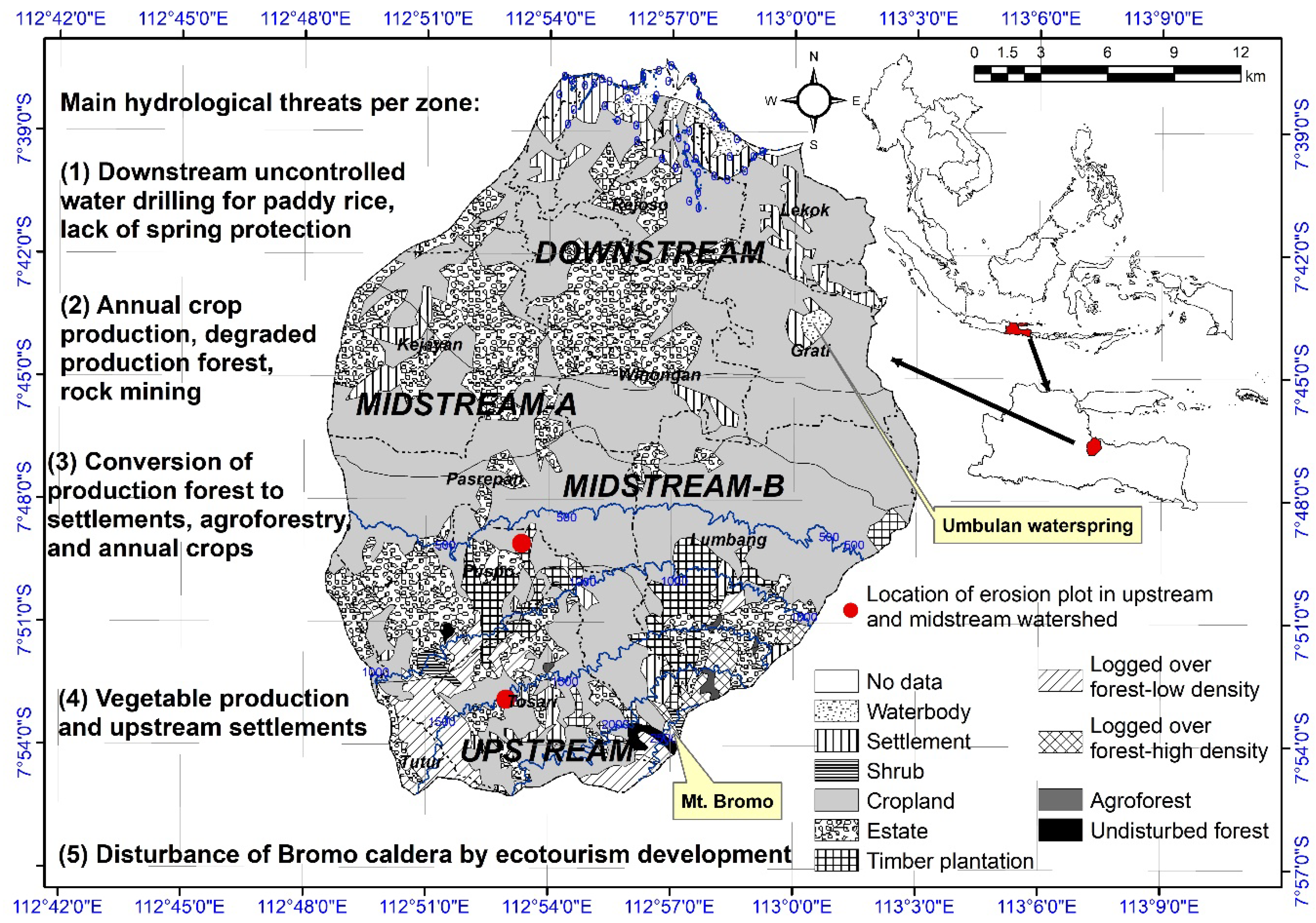
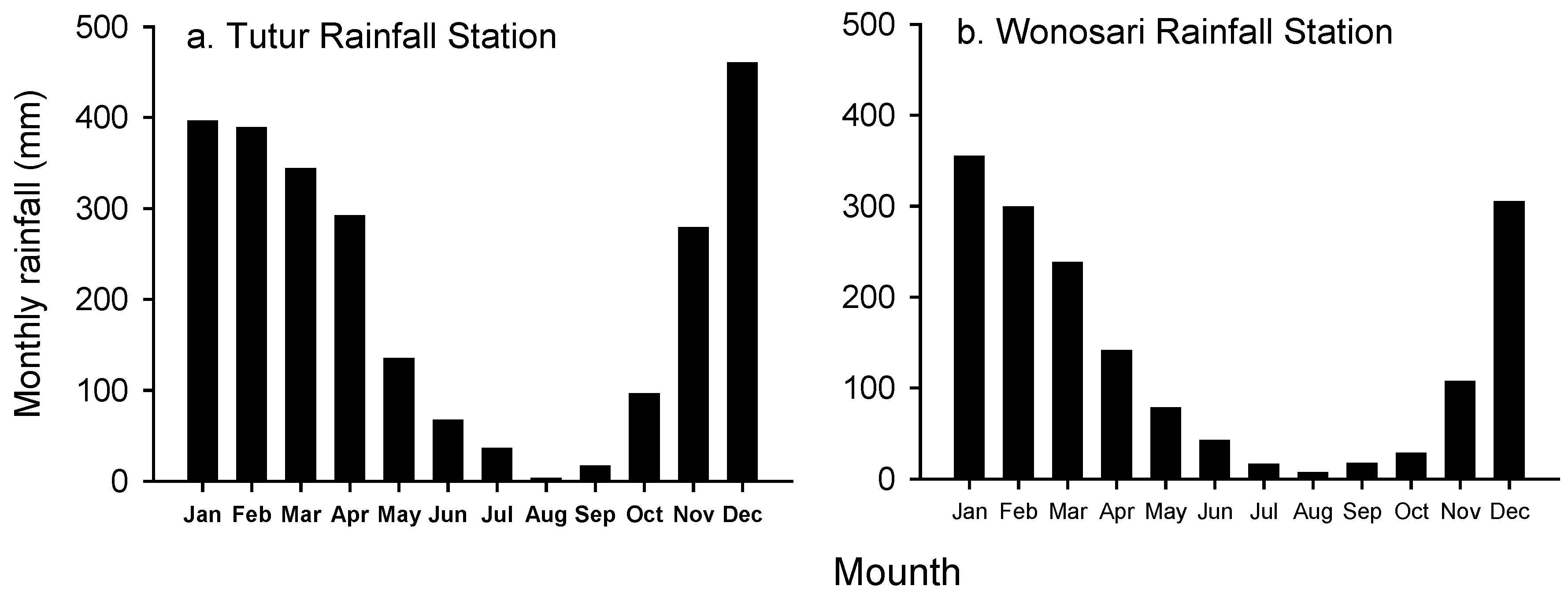
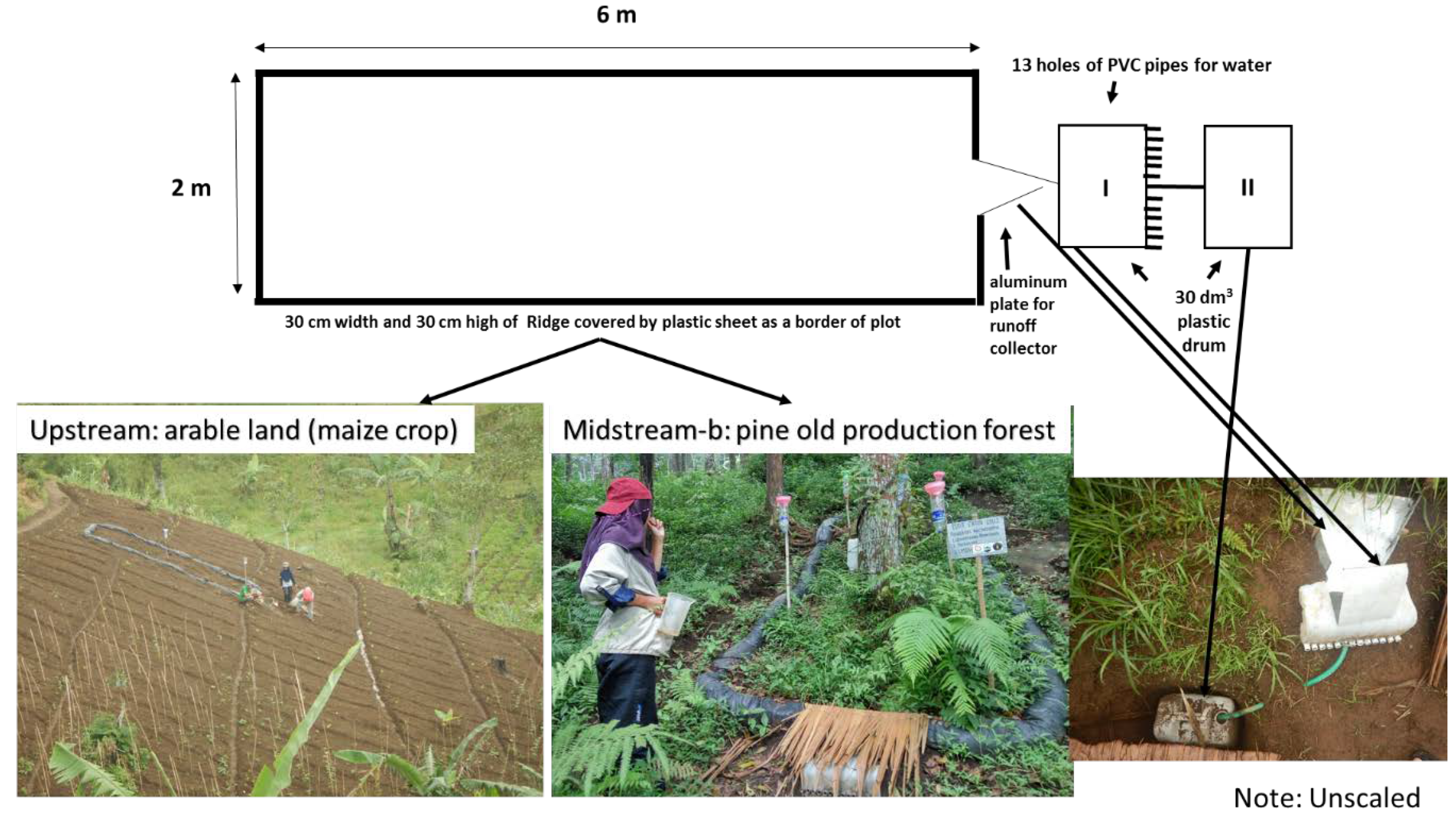


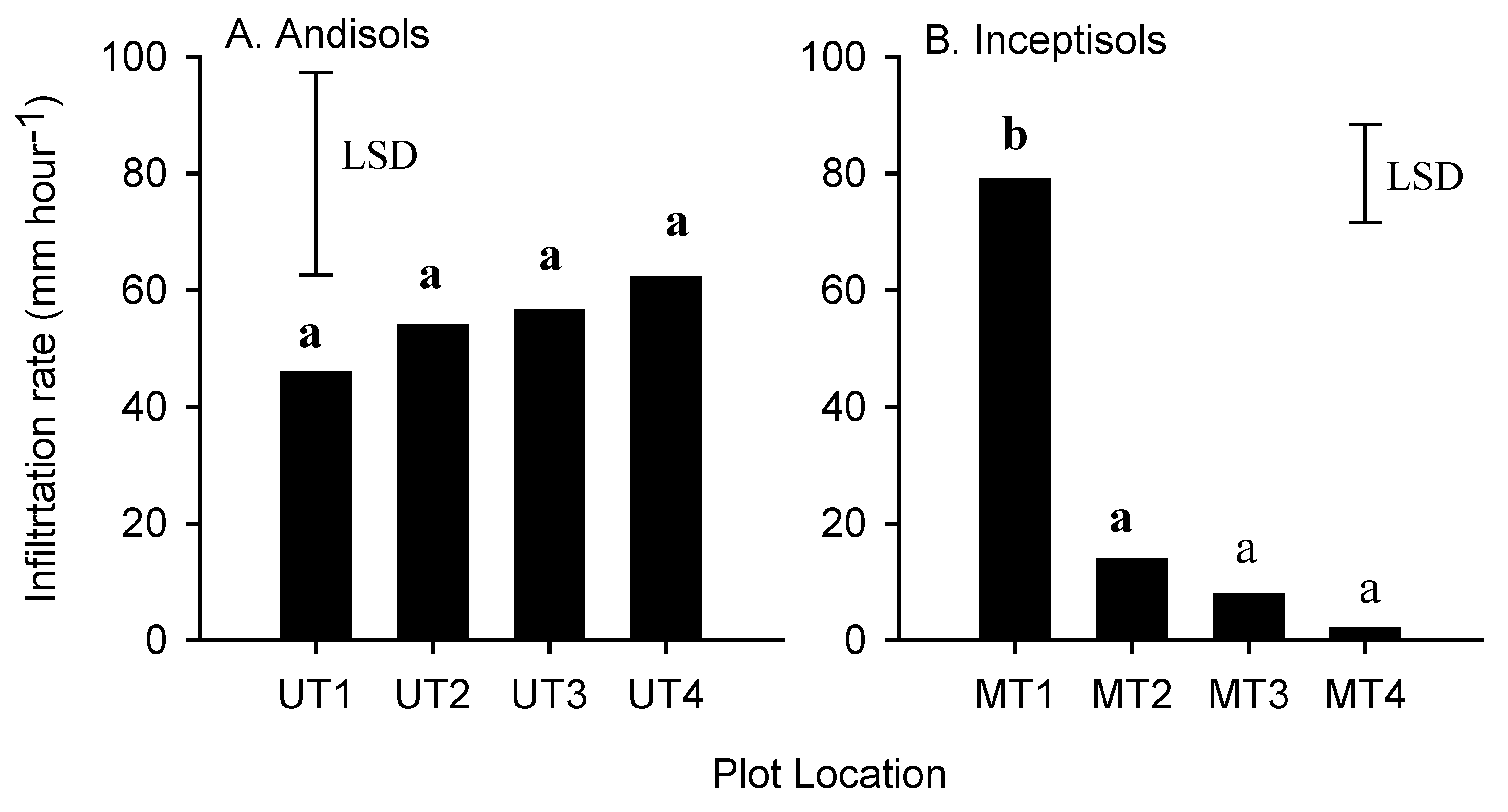
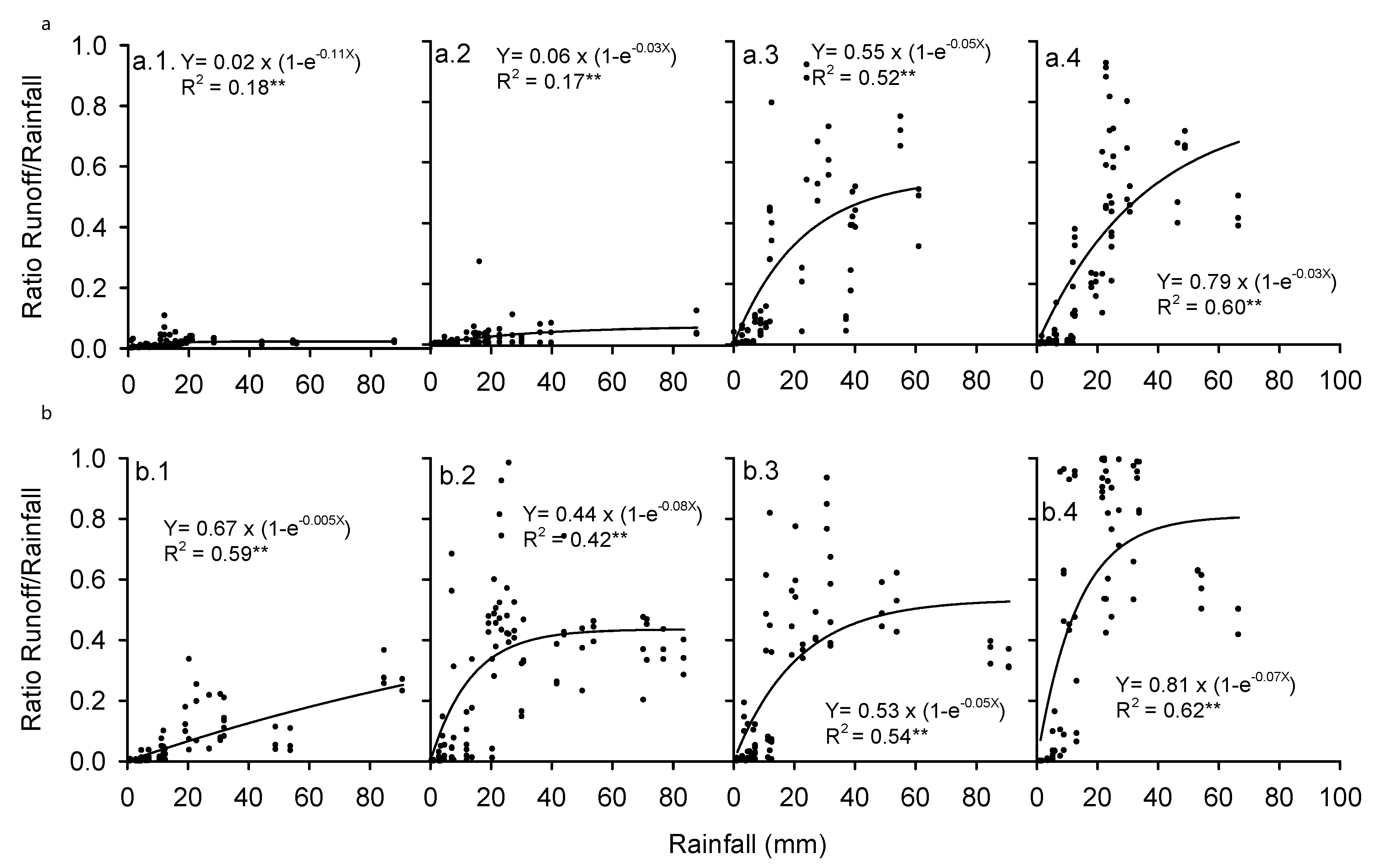
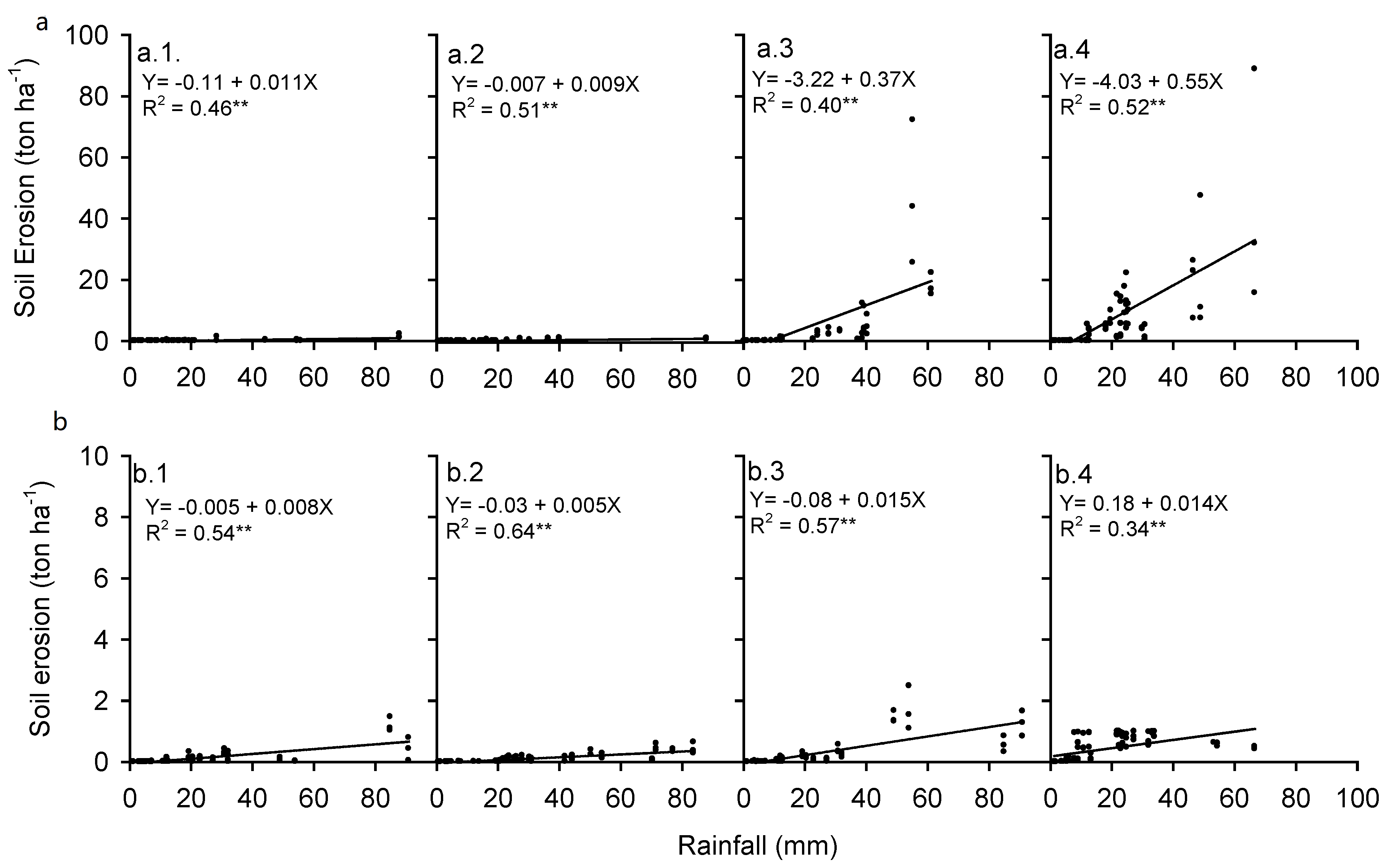
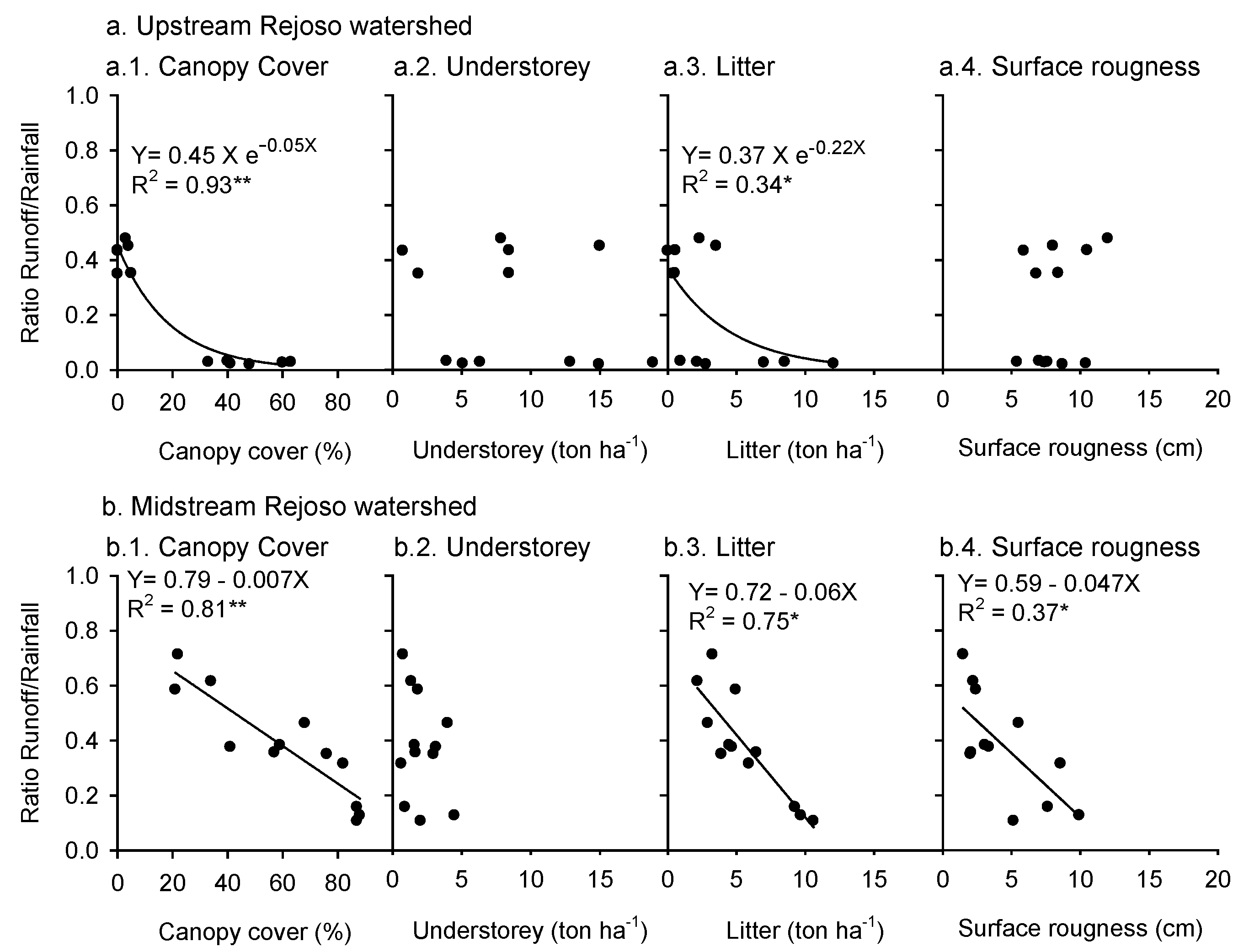

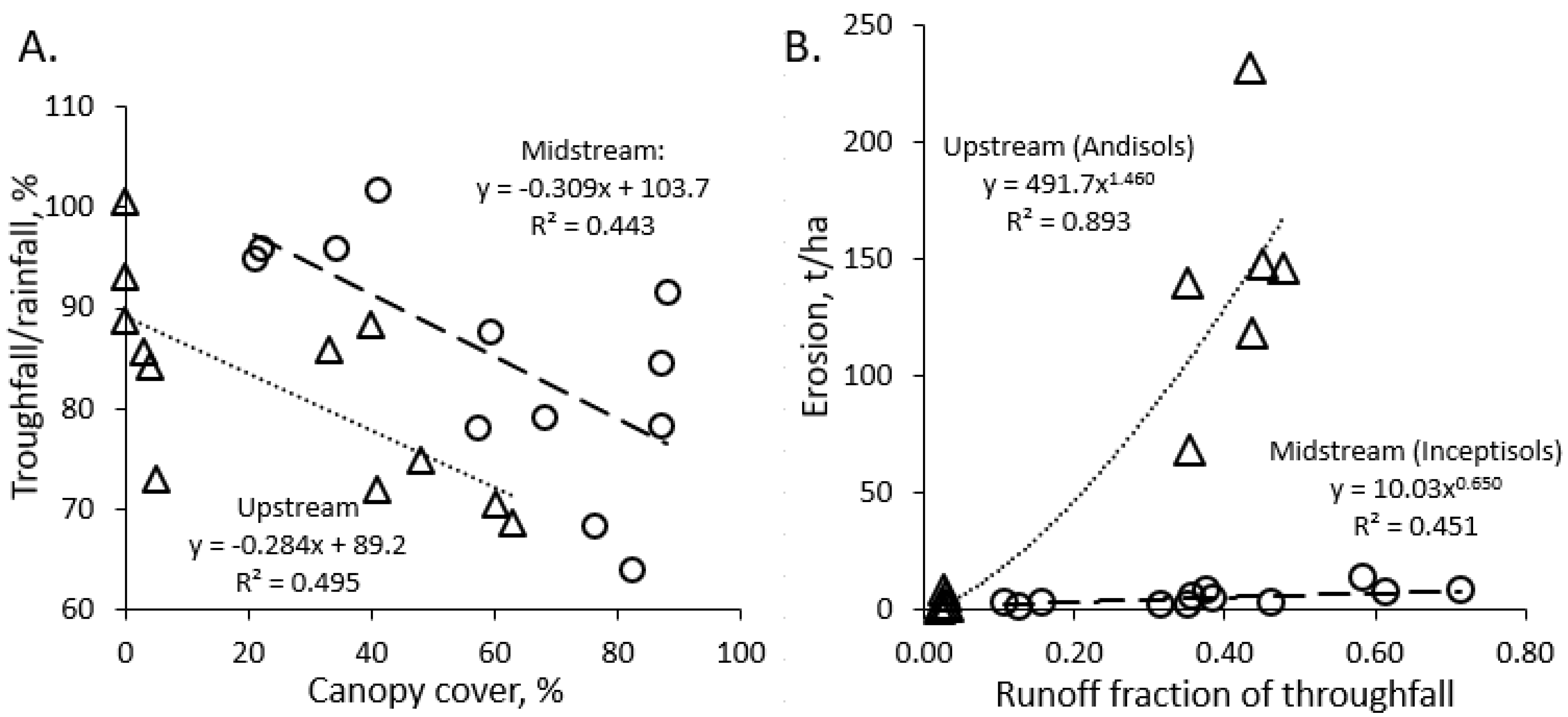
| Code | Land Use | Vegetation (the Average Height of Trees) | Terracing | Slope (Plot Level, %) |
|---|---|---|---|---|
| Upstream Rejoso Watershed | ||||
| UT1 | Old production forest | Pine (Pinus merkusii) (34 m) + grass | None | 35–40 |
| UT2 | Young production forest | Pine (11 m) + grass | None | 50–60 |
| UT3 | Agroforestry | Strip cemara (Casuarina junghuniana) (13 m) + cabbage | None | 40–50 |
| UT4 | Arable land | Banana, maize, carrot | None | 40–50 |
| Midstream Rejoso Watershed | ||||
| MT1 | Old production forest | Mixed pine (28 m) or mahogany (Swietenia macrophylla) (12 m), banana, salak (Salacca zalacca), taro (Colocasia esculenta), elephant grass (Miscanthus giganteus). | Bench terrace sloping outward | 3–8 |
| MT2 | Agroforestry | Coffee-based (2 m) mix with durian (Durio zibethinus) (10 m), mahogany (9 m), Leucaena leucocephala (8 m), Paraserianthes falcataria (11 m), Albizia saman (11 m), dadap (Erythrina variegata) (11 m), banana | Bench terrace sloping outward | 3–8 |
| MT3 | Agroforestry | Clove (Syzygium aromaticum) (8 m), banana | Bench terrace sloping outward | 3–8 |
| MT4 | Agroforestry | Mango (Mangifera indica) (10 m), durian (10 m), Randu kapuk (Ceiba pentandra) (11 m), maize, cassava, groundnut | Bench terrace sloping outward | 3–8 |
| Location Code at Soil Depth (cm) | Bulk Density (g cm−3) * | Particle Density (g cm−3) * | Soil Porosity (%) * | Soil Macro- Porosity (%) | Corg (%) * | ||||||||||||||
|---|---|---|---|---|---|---|---|---|---|---|---|---|---|---|---|---|---|---|---|
| 0–10 | 10–20 | 20–30 | 0–10 | 10–20 | 20–30 | 0–10 | 10–20 | 20–30 | 0–10 | 10–20 | 20–30 | 0–10 | 10–20 | 20–30 | |||||
| Upstream Rejoso Watershed: Andisols | |||||||||||||||||||
| UT1 | 0.87a | 0.81a | 0.83a | 2.16a | 2.23a | 2.31a | 60a | 63a | 64c | 8.0b | 5.2b | 0.9a | 2.05bc | 1.61c | 1.79b | ||||
| UT2 | 0.85a | 0.86a | 0.82a | 2.27a | 2.30a | 2.33a | 63a | 63a | 65c | 5.1ab | 1.5a | 0.3a | 2.46c | 1.56bc | 1.78b | ||||
| UT3 | 0.81a | 0.84a | 0.85a | 2.14a | 2.12a | 2.28a | 62a | 60a | 63b | 4.7ab | 2.1ab | 1.4a | 1.17a | 0.58a | 0.71a | ||||
| UT4 | 0.84a | 0.88a | 0.84a | 2.28a | 2.29a | 2.08a | 63a | 62a | 60a | 3.0a | 0.3a | 0.1a | 1.35ab | 1.06ab | 0.92a | ||||
| LSD | 0.07 | 0.13 | 0.12 | 0.17 | 0.21 | 0.38 | 4 | 5 | 1 | 3.52 | 3.4 | 1.8 | 0.85 | 0.50 | 0.50 | ||||
| Midstream Rejoso Watershed: Inceptisols | |||||||||||||||||||
| MT1 | 0.83a | 0.85a | 0.83a | 2.20a | 2.28a | 2.20a | 62c | 63a | 62b | 13.6ab | 7.0bc | 2.5c | 1.73a | 1.87a | 1.65b | ||||
| MT2 | 0.96b | 0.91a | 0.91a | 2.42b | 2.38a | 2.21a | 60bc | 62a | 59ab | 16.1b | 8.3c | 1.8bc | 2.22a | 1.59a | 1.84b | ||||
| MT3 | 1.03bc | 0.96a | 0.94ab | 2.38b | 2.36a | 2.40a | 57ab | 59a | 61b | 11.7a | 3.4ab | 0.9ab | 2.19a | 1.61a | 1.01a | ||||
| MT4 | 1.09c | 1.04a | 1.04b | 2.38b | 2.33a | 2.33a | 54a | 55a | 55a | 11.4a | 0.8a | 0a | 1.71a | 1.36a | 1.12a | ||||
| LSD | 0.10 | 0.24 | 0.11 | 0.15 | 0.17 | 0.22 | 4 | 10 | 4 | 4.0 | 3.9 | 1.0 | 0.84 | 0.54 | 0.41 | ||||
| Code | Land Cover | Tree Canopy Cover (%) * | Understory Vegetation (Mg ha−1) * | Litter (Mg ha−1) * | Soil Roughness (%) * |
|---|---|---|---|---|---|
| Upstream Rejoso Watershed | |||||
| UT1 | Old production forest | 55b | 10.1b | 9.2b | 8.5a |
| UT2 | Young production forest | 40b | 10.5b | 2.0a | 7.0a |
| UT3 | Agroforestry | 4a | 10.1b | 2.1a | 9.5a |
| UT4 | Arable land | 0a | 3.7a | 0.3a | 7.7a |
| LSD | 15 | 5.6 | 3.7 | 4.6 | |
| Midstream Rejoso Watershed | |||||
| MT1 | Old Production Forest | 87c | 2.5a | 9.8b | 7.6b |
| MT2 | Agroforestry | 75c | 2.5a | 4.8a | 5.4ab |
| MT3 | Agroforestry | 52b | 2.1a | 5.2a | 2.8a |
| MT4 | Agroforestry | 26a | 1.3a | 3.5a | 2.0a |
| LSD | 14 | 2.6 | 2.4 | 4.5 | |
| Code | Land Cover | Rainfall (mm) | Runoff (mm) * | Runoff/Rainfall Ratio * | Runoff/Throughfall Ratio * | Soil Erosion (Mg ha−1) * |
|---|---|---|---|---|---|---|
| Upstream Rejoso Watershed | ||||||
| UT1 | Old production forest | 555 | 14.3a | 0.03a | 0.04a | 5.86a |
| UT2 | Young production forest | 492 | 13.2a | 0.03a | 0.03a | 1.47a |
| UT3 | Agroforestry | 476 | 203.3b | 0.43b | 0.56c | 120.98b |
| UT4 | Arable land | 556 | 225.7b | 0.41b | 0.43b | 163.22b |
| LSD | 46.3 | 0.09 | 0.11 | 87 | ||
| Midstream Rejoso Watershed | ||||||
| MT1 | Old Production Forest | 616 | 80.2a | 0.13a | 0.16a | 3.07a |
| MT2 | Agroforestry | 841 | 316.3c | 0.38b | 0.48b | 2.88a |
| MT3 | Agroforestry | 616 | 228.8b | 0.37b | 0.46b | 6.63ab |
| MT4 | Agroforestry | 541 | 344.9c | 0.64c | 0.66c | 10.33b |
| LSD | 86.6 | 0.12 | 0.12 | 4.22 | ||
© 2020 by the authors. Licensee MDPI, Basel, Switzerland. This article is an open access article distributed under the terms and conditions of the Creative Commons Attribution (CC BY) license (http://creativecommons.org/licenses/by/4.0/).
Share and Cite
Suprayogo, D.; van Noordwijk, M.; Hairiah, K.; Meilasari, N.; Rabbani, A.L.; Ishaq, R.M.; Widianto, W. Infiltration-Friendly Agroforestry Land Uses on Volcanic Slopes in the Rejoso Watershed, East Java, Indonesia. Land 2020, 9, 240. https://doi.org/10.3390/land9080240
Suprayogo D, van Noordwijk M, Hairiah K, Meilasari N, Rabbani AL, Ishaq RM, Widianto W. Infiltration-Friendly Agroforestry Land Uses on Volcanic Slopes in the Rejoso Watershed, East Java, Indonesia. Land. 2020; 9(8):240. https://doi.org/10.3390/land9080240
Chicago/Turabian StyleSuprayogo, Didik, Meine van Noordwijk, Kurniatun Hairiah, Nabilla Meilasari, Abdul Lathif Rabbani, Rizki Maulana Ishaq, and Widianto Widianto. 2020. "Infiltration-Friendly Agroforestry Land Uses on Volcanic Slopes in the Rejoso Watershed, East Java, Indonesia" Land 9, no. 8: 240. https://doi.org/10.3390/land9080240
APA StyleSuprayogo, D., van Noordwijk, M., Hairiah, K., Meilasari, N., Rabbani, A. L., Ishaq, R. M., & Widianto, W. (2020). Infiltration-Friendly Agroforestry Land Uses on Volcanic Slopes in the Rejoso Watershed, East Java, Indonesia. Land, 9(8), 240. https://doi.org/10.3390/land9080240







